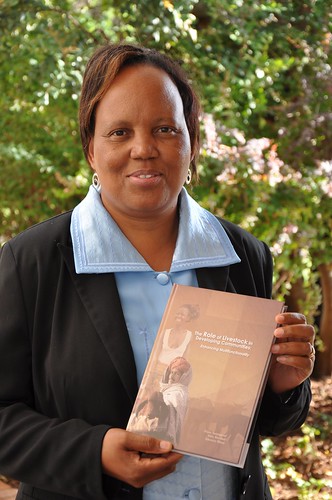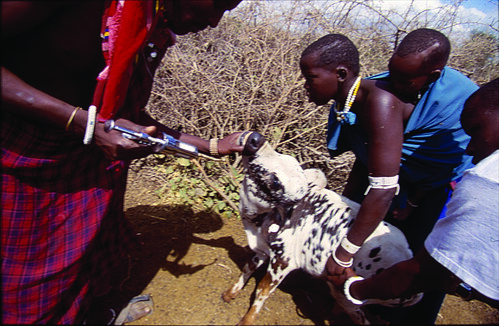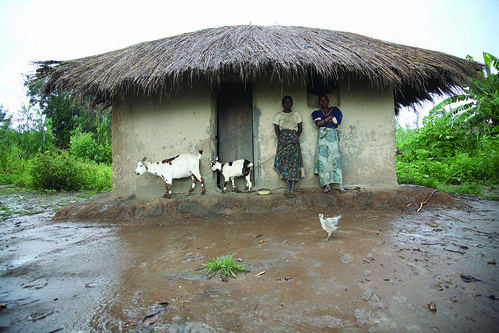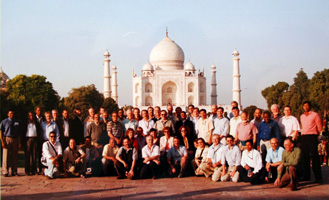Siboniso Moyo, ILRI’s representative for southern Africa, holds a copy of ‘The role of livestock in developing communities: Enhancing multifunctionality’ which was recently launched in South Africa (photo credit: ILRI).
A new book co-published by the University of the Free State South Africa, the Technical Centre for Agricultural and Rural Cooperation (CTA) and the International Livestock Research Institute (ILRI) calls for more investment in livestock production to fight poverty and promote human health in developing countries.
The role of livestock in developing communities: Enhancing multifunctionality was launched on 9 November 2010 at the University of the Free State, in Bloemfontein, South Africa.
Farm animals continue to play several central roles in the livelihoods of the people in developing countries, ranging from providing households with high-quality foods, good nutrition and regular incomes to providing labourers with jobs, community members with social status and farmers and herders with ways to sustain food production.
This book highlights the livestock sector’s contribution to the social and economic progress of developing communities and advocates public- and private-sector investments in livestock production.
The publication is a product of a satellite symposium that was part of the 10th World Conference on Animal Production, held in Cape Town in November 2008. The symposium, jointly organized by ILRI and the University of the Free State, focused on livestock livelihood strategies for meeting the United Nations Millennium Development Goals.
‘We were pleased with the chance to work together with the University of the Free State in a side event during the World Conference of Animal Production 2008, which led to the production of this book,’ said Siboniso Moyo, ILRI’s representative for southern Africa, during the launch.
Moyo, along with Frans Swanepoel, senior director of research and professor of sustainable agriculture at the University of the Free State, Bloemfontein, South Africa, and Aldo Stroebel, director of international affairs and associate professor at the Center for Sustainable Agriculture and Rural Development at the same university, provided editorial oversight for the book.
John McDermott, ILRI’s deputy director general for research; Canagasaby Devendra, a tropical animal production specialist who formerly worked at ILRI, and Akke van der Zijpp, another former ILRI staff member who is now professor in livestock production systems at the Wageningen University and Research Centre, in the Netherlands, served in the editorial advisory committee that steered production of the book.
‘The “multifunctionality” of livestock is an important concept to understand when working with developing communities,’ said Moyo. ‘Viewing research and development challenges through a livestock lens,’ she said, ‘can help us make even greater use of the many functions livestock serve in poor communities and so as to increase their contribution to livelihoods.’
The book launch was attended by Monty Jones, executive director of the Forum for Agricultural Research in Africa, chairperson of the Global Forum of Agricultural Research and a World Food Prize Laureate (2004), who contributed the foreword to the book, and Norman Casey, president of the 10thWorld Conference of Animal Production 2008.
The book describes successful livestock development strategies, including ways to promote gender equality and to empower women through livestock development and ways to develop small-scale livestock enterprises without harming the environment.
Targeting academic professionals, industry experts, government officials and academics interested in increasing the contributions livestock enterprises can make to human well-being and developing-country economies, the new publication includes case studies and frameworks, discussions of key global policy development issues, and the main challenges and constraints of smallholder livestock production systems around the world.
—
The book is available in South Africa through Sun Media Bloemfontein and can be ordered through their e-shop: http://www.sun-e-shop.co.za/?Task=moreinfo&SKU=ISBN+978-0-86886-798-4
View ILRI slide presentations made at the satellite symposium during the 10th World Conference on Animal Production: www.ufs.ac.za/wcapsatellite





